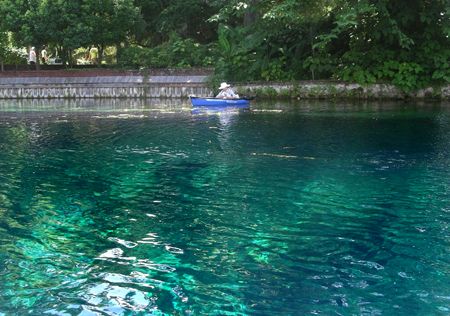
Ev (Val's mother) in Silver Springs, July 2010
As a small child, I visited the Silver Springs theme park with my family and we rode in the glass-bottomed boats. I don't remember much about the earliest trip, except that there were huge catfish down in the springs and they looked like dark gray sharks with whiskers and a big round head.
The first time I really recall my impressions of the springs was when my sister and I paddled our newly acquired kayaks up the river from a small boat launch several miles downstream. We were teenagers and it was in the late 1970s. We'd gotten to the riverside park in the late afternoon and by the time we reached the springs, it was around 6 PM. As we floated above Mammoth Spring, the sense of vertigo was incredible. The water was so clear that it seemed nonexistent, and the white bottom of the spring, some 70 feet below, produced a blue that looked more like atmosphere than liquid. I was flying with no visible means of support!
 Ev (Val's mother) in Silver Springs, July 2010 |
The huge fish swam slowly through this glass-like substance, including those enormous catfish, black against the white bottom. Gars, bluegills and bass mingled with turtles. The late hour meant that there were no tour boats to disturb us, and there was little breeze to ripple the water's surface. It was like sliding around on a sheet of glass and the lack of visual reference points below me made balance a bit of an issue. As long as I looked at the shoreline I was okay, but those exhilarating glimpses of the water below me were mesmerizing, even if I did feel like I was falling, such as in a dream.
The trip up and down the Silver River sometimes felt like we were gliding above a field of bright green eelgrass. Sometimes it was shallow and other times deep, but the clarity of the colors was unreal. Patches of white sand and thick stands of emerald eelgrass provided the setting for innumerable fish, including bowfin and mullet, and we watched turtles swim in and out of the vegetation. This landscape was punctuated by those stunning blue holes that indicated the locations of springs.
I've returned to Silver Springs several times over the past 30+ years. While it is still an enjoyable trip, there has been a massive and ominous change. The water remains clear, but it is not clean. It doesn't even smell bad, so you would never know that it is polluted by nitrates, the runoff from thousands of lawns that have been added over the spring recharge zone. The concentration of invisible contaminants is made even greater because the flow of the springs is now less than it was when I first saw the river.
So how can I tell the water is not clean anymore? Well, for one thing, the catfish are gone. I've heard people say they disappeared because they were eaten by alligators. Well, there were alligators before and they didn't eat all the catfish. There is now a new fish, the Plecostomus, which some folks mistake for catfish. This dark brown piscine is, yes, the same one that eats algae in aquariums. Plecostomus, sometimes called Armored Catfish, are common now in many Florida rivers, growing to almost two feet in length (nothing compared to the size that the catfish used to reach). Another thing that is a bit disturbing is that it is common to find fish with strange growths on their heads and bodies. Bowfin and bluegills seem to sport these white puffy masses more than other species. Gars don't seem to be affected at all. These might be a fungus, bacteria, or cancer. I'm not a biologist, so I am just making guesses, but I doubt that the growths are completely benign.
But the most telling sign the springs have changed is in the look of the water. You can no longer experience what I described earlier: that sense of vertigo while floating over light blue liquid with almost no sense of solid land beneath. Everything underwater is now coated with a gooey black algae. Rocks, sand, logs and eelgrass are all affected; the algae sometimes looks like grungy fur or just black mucus. It is straight out of a sci-fi horror flick, and I don't mean something as innocuous as "The Creature from the Black Lagoon," which, along with early Tarzan films, "The Yearling" and "Sea Hunt" episodes, was actually filmed at Silver Springs. This one is more like "The Slime that Suffocated Silver Springs."
Okay, so I'm being a bit melodramatic, but it is quite disappointing that the pristine qualities that once drew people to the area are no longer present. The water is still a lovely shade of blue, but it is a darker blue now, more like turquoise than sapphire. The backdrop of black produces a different effect as one paddles over it and the bottom of the river and springs appears solid and not at all ephemeral. Fish disappear into globs of black instead of ribbons of bright green. And only the very centers of the springs still have white sand, where the force of the water keeps churning the particles so that the algae cannot hold on.
Much has been written about the effects of rising population, increased pollution and other changes around Florida's sparkling springs. There will probably never be any kind of intense effort made to restore the environment and, in practical terms, it is most likely impossible. People need a place to live and will always have an impact where they do so. The simple fact remains: the springs grow ever darker.